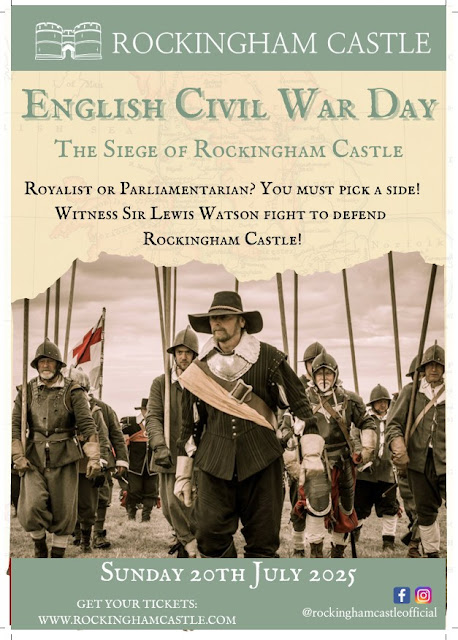The Siege of Rockingham Castle 20.07.2025 POSTPONED

Rockingham Castle, a historic fortress with over 900 years of history.
Introduction
The English Civil War (1642–1651) was a seismic event in Britain’s history—pitting monarch against Parliament and dividing families, counties, and castles. Among the many strongholds affected by the conflict was Rockingham Castle, a Norman bastion turned Royalist stronghold that found itself besieged during the war’s upheaval.
The English Civil War: A Nation Divided
The roots of the English Civil War lay in political power struggles and religious tension. King Charles I’s belief in the divine right of kings, his attempts to govern without Parliament, and efforts to enforce Anglican uniformity led to widespread resistance.
When war finally broke out in 1642, the country was split between the Royalists (Cavaliers), who supported the king, and the Parliamentarians (Roundheads), who demanded reform. The war quickly escalated from isolated skirmishes to full-scale battles, affecting towns, villages, and castles across England.

The English Civil War raged across England from 1642 to 1651, altering the nation forever.
Rockingham Castle: A Royalist Stronghold
Located in Northamptonshire, Rockingham Castle was built on the orders of William the Conqueror in the 11th century. Its strategic hilltop position and robust defenses made it a formidable fortress.
By the time of the Civil War, the castle had passed into the hands of the Watson family, loyal Royalists. Lewis Watson, 1st Baron Rockingham, held the castle on behalf of the king, making it a natural target for Parliamentarian forces seeking to consolidate control in the Midlands.
The Siege of Rockingham Castle
Although not as well-documented as major battles, the Siege of Rockingham Castle likely occurred in late 1643 or early 1644, during Parliament’s push into Northamptonshire. Under siege by Parliamentarian troops, the castle’s defenders faced dwindling supplies and an untenable position.
Rather than suffer a devastating bombardment or prolonged siege, Watson surrendered the castle—reportedly under favorable terms. This spared the castle from major destruction, though like many others during the war, it was later slighted (partially demolished) to prevent further military use.
🗣️ “The house is not so strong that it can be defended, nor is it provided with such a store of victuals as will maintain a siege.”
— Typical reasoning from Civil War correspondence (paraphrased)
Aftermath and Restoration
Following the siege, Rockingham’s role as a military asset ended. The Watson family reclaimed it after the Restoration of the monarchy in 1660. Over the centuries, it evolved into a stately home, preserving its medieval character while adapting to modern times.
Today, Rockingham Castle stands as a rare testament to over 950 years of continuous occupation, and to a period when civil conflict transformed England’s landscape.

The castle’s interior today, restored and open to visitors.
Plan Your Visit
Rockingham Castle is now open to the public on select days throughout the year. Guided tours, family-friendly events, and beautiful gardens offer a unique opportunity to walk through nearly a millennium of British history.
👉 Visit the official website to plan your trip: https://www.rockinghamcastle.com
Further Reading
- Gaunt, Peter. The English Civil War: A Military History. I.B. Tauris, 2014.
- Royle, Trevor. Civil War: The Wars of the Three Kingdoms 1638–1660. Abacus, 2004.
- Rockingham Castle official archives
Final Thought
The siege of Rockingham Castle may not have made front-page history, but it tells a powerful story: of loyalty, resilience, and survival in the face of a war that reshaped a nation. Visiting the castle today offers not just a glimpse into the past—but a connection to the lives caught in the storm of civil war.




Comments
Post a Comment